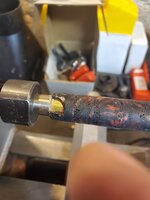HoleyDiver
Member
Hello,
As title states acrylic blank chipped. First time turning acrylic blank. I was using carbide tools. All was fine while turning with square cutter but once I switched to round I started getting pits and then then this big chip broke off. Any guidance or advice would be very much appreciated. I am very new to turning. That k you very much.
JB
As title states acrylic blank chipped. First time turning acrylic blank. I was using carbide tools. All was fine while turning with square cutter but once I switched to round I started getting pits and then then this big chip broke off. Any guidance or advice would be very much appreciated. I am very new to turning. That k you very much.
JB

